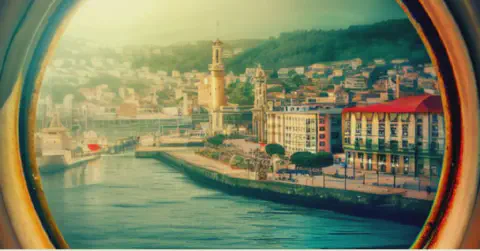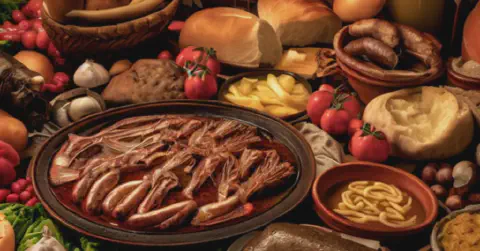
Camino Inglés : The Ultimate Guide For Pilgrims and Hikers
Posted: | Updated:
Reading time: 22 minutes
Camino Inglés : The Ultimate Guide For Pilgrims and Hikers
Posted: | Updated:
Reading time: 22 minutes
By: Simon Kemp, Editor
A Comprehensive Guide to the Camino Inglés
If you’re looking for a special and rewarding, but physically demanding travel experience, the Camino Inglés may be just the right choice for you. This historic pilgrimage route is steeped in tradition and offers breathtaking scenery and cultural immersion.
The Camino Inglés, or the English Way, is one of the lesser-known routes to Santiago de Compostela in northern Spain. It was historically used by English and Irish pilgrims who arrived by boat in the port of Ferrol and walked the route to Santiago. Today, it remains a popular alternative to the more crowded Camino Francés, offering a more tranquil and personal experience.
Walking the Camino Inglés typically takes around six days, although it can be completed in as few as four days or extended to include additional routes such as the Muxía and Finisterre Extensions. The route covers a distance of approximately 119 kilometers and offers a variety of terrain, from coastal paths to rural landscapes.
Planning is essential when embarking on the a trip like this. Pilgrims should consider the best time to go, obtain a pilgrim passport, and book accommodation in advance. They should also prepare physically and mentally for the journey and be aware of safety considerations and medical insurance.
Pilgrims can enjoy the timeless beauty of Galicia along the way, including breathtaking beaches, quaint medieval villages, and lush green forests. The English Way is also home to several cultural and historical landmarks , including the Tower of Hercules in A Coruña and the Monastery of Santa María in Sobrado dos Monxes.
Whether you’re a seasoned pilgrim or a first-time traveler, the Camino Inglés offers a unique and unforgettable journey. With its rich and historical landmarks, wide open landscapes, and cultural significance, walking this Camino route is without doubt, the experience of a lifetime.
The History and Significance of the Camino Inglés
The English Way has a rich and fascinating history that spans over a thousand years.
The Camino Inglés is a path within a larger network of pilgrimage routes called the Camino de Santiago . This network leads to Santiago de Compostela in Galicia, Spain. The Camino de Santiago has been a significant pilgrimage route in Europe for centuries and attracts travelers from all around the world who seek a spiritual journey.
Origins of the Camino de Santiago
According to legend, after the apostle St. James was beheaded in Jerusalem, his body was transported by boat to the northwestern coast of Spain. The site where his body was buried became a place of pilgrimage and devotion, and over time, a network of pilgrimage routes developed throughout Europe leading to Santiago de Compostela. The Camino de Santiago, or the Way of St. James, became a symbol of devotion and penance for Christian believers and has maintained this reputation to this day.
The Camino Inglés and its History
The Camino Inglés, or “English Way,” was one of the main pilgrimage routes to Santiago de Compostela during the Middle Ages, particularly for pilgrims from England and northern Europe. The name “Camino Inglés” is believed to come from the many English pilgrims who arrived in Galicia by sea, landing in the port of Ferrol before continuing on to Santiago de Compostela. Over time, the route became more and more important and became a means for merchants to transport goods and ideas throughout Europe.
The Cultural and Religious Importance of the Camino Inglés
The Camino Inglés has attracted people from all backgrounds, from the nobility to the common folk, as a path of pilgrimage. Is has has greatly influenced the culture and religion of Europe. The route has inspired many works of literature, art, and music, which have encouraged countless people to undertake the journey for spiritual or personal reasons. Despite its decline in popularity during the modern era, the Camino Inglés has experienced a resurgence in recent times, with more and more pilgrims and travelers interested in embarking on their own Camino adventure.
The Camino Inglés is not only an ancient pilgrimage route but also an essential part of European history and culture. It offers a unique and transformative experience for those who are up for the challenge of a lifetime!
Planning Your Journey
Are you ready for an adventure on the Camino Inglés? Plan for success by considering a handful of important factors to make sure that your adventure is both safe and fun.
Timing: You can walk the Camino Inglés whenever you like, but the most comfortable time to go is from May to October when the weather is warmer and the days are longer.
Route: The Camino Inglés begins in Ferrol and ends in Santiago de Compostela, covering a distance of approximately 120 kilometers. You have the option to walk the entire Camino Inglés route or just a part of it based on your preference and schedule.
Accommodation: There are different types of places to stay along the Camino Inglés, such as hostels and hotels. It’s recommended to book your accommodation beforehand, especially during the busy summer months.
Equipment: It’s important to pack wisely and bring comfortable walking shoes, a backpack, and appropriate clothing for the weather. You can also consider bringing a walking stick, water bottle, and basic first aid kit.
Training: Walking the Camino Inglés requires a moderate level of fitness. It’s important to train beforehand by taking long walks and building up your endurance.
Budget: The cost of the Camino Inglés can vary depending on your accommodation choices and how much you spend on food and other expenses. Plan your budget in advance to avoid any surprises.
Transportation: You can easily get to Ferrol, the starting point of the Camino Inglés, by bus or train from major cities in Spain. If you can also arrange for transportation back to your starting point or to the airport either before or after you reach Santiago de Compostela.
By considering these factors and planning ahead, you can ensure a safe and enjoyable journey on the Camino Inglés.
Deciding When to Go
When you’re planning to travel along the Camino Inglés, it’s essential to think about the season of the year. Summertime, particularly July and August, is the busiest time for pilgrims.
If you prefer a quieter and more peaceful experience, consider going during the shoulder seasons of spring or fall. Remember, the weather on the Camino Inglés can be unpredictable.
Obtaining a Pilgrim Passport
To start your journey on the Camino Inglés, you need to get a pilgrim passport or “credencial.” It’s a necessary document that lets you stay in the official pilgrim hostels and receive the “Compostela,” a certificate of completion given to pilgrims who finish the route in Santiago de Compostela.
Pilgrim passports are available at most albergues (hostels) and tourist offices along the route.
Booking Accommodation
Accommodation along the Camino Inglés ranges from basic hostels to luxury hotels, but it’s important to book in advance during the peak season to ensure availability.
Most pilgrims choose to stay in the albergues, which are affordable and offer a communal atmosphere. Some albergues offer reservations, while others operate on a first-come, first-served basis.
It’s also possible to book private accommodation, such as hotels or guesthouses, along the route.
Preparing Physically and Mentally for the Journey
Walking the Camino Inglés is a physical and mental challenge, so it’s important to prepare yourself in advance.
Start with short walks and gradually increase the distance over time. It’s also important to wear comfortable and sturdy footwear and bring a well-fitting backpack.
Mental preparation is also important, as the journey can be emotionally taxing.
Setting realistic goals, practicing mindfulness, and allowing time for rest and reflection can all be helpful in preparing for the journey.
Safety Considerations and Medical Insurance
While the Camino Inglés is generally a safe route, it’s important to take precautions to ensure your safety.
This includes being aware of your surroundings and belongings, staying on marked paths, and carrying a charged phone and emergency whistle.
Get travel insurance that includes medical coverage and make sure you’ve received any necessary vaccinations before starting your journey.
This will make sure you experience less drama in case of any medical emergencies along the way.
Before embarking on the Camino Inglés, it’s recommended to research and understand the health services available along the route.
Carry any necessary medications with you, just in case you need them.
Camino Inglés Route Map
This map shows the complete route along the Spanish Camino Inglés starting from either Ferrol or A Coruna. You can use this map to plan your journey and track your planned journey before you set out on your walk. You can zoom into the map and open it in a new page for a fuller view. It is possible to zoom right into a particular location and see what the terrain is like in that area. Using this map, you can do a complete virtual tour of the entire Camino Inglés.
The Camino Inglés Route
The Camino Inglés is a well-known and ancient pilgrimage route that stretches for 120 kilometers (75 miles) through the beautiful region of Galicia in northern Spain. Join people from all over the world and walk this historic route that starts in the port city of Ferrol. Here is an overview of the Camino Inglés route, its seven stages, and what you can expect on each stage, including the distance, terrain, and landmarks.
Each of the seven stages of the Camino Inglés has its own distinct landmarks and characteristics, making for a diverse and fulfilling journey. The entire route of 120 kilometers (75 miles) usually takes between 5-6 days to complete. You will end in Santiago de Compostela, where you can visit the renowned Cathedral of Santiago.
As you travel along the Camino Inglés, you will be greeted with breathtaking landscapes, charming towns, and significant landmarks with deep cultural and religious significance. You will also have the chance to meet fellow pilgrims from various backgrounds and gain insight into the unique traditions and culture of Galicia.
Camino Inglés route’s seven stages
- Ferrol to Neda
- Neda to Pontedeume
- Pontedeume to Betanzos
- Betanzos to Mesón do Vento
- Mesón do Vento to Hospital de Bruma
- Hospital de Bruma to Sigüeiro
- Sigüeiro to Santiago de Compostela
Each stage covers a different distance, terrain, and landmarks. You will cross rivers, climb hills, and walk through forests, but you will also pass through historic towns, ancient bridges, and beautiful churches.
There are also alternative routes and variations available, such as the Northern Variant, which is a more challenging and scenic route that takes you through the coast of Galicia. There are also the Muxía and Finisterre Extensions that will take you to the beautiful coastal towns of Muxía and Finisterre.
Regardless of which route you take, the Camino Inglés is a journey of a lifetime that will challenge and inspire you, providing a unique opportunity for spiritual and personal growth.
Camino Inglés Detailed Description of Each Stage
| Stage | Description | Distance | Terrain | Landmarks |
|---|---|---|---|---|
| 1 | Ferrol to Neda | 14 km | Mostly flat with a few gentle climbs, beautiful rural landscapes and small villages | Chapel of Our Lady of the Anguish, Neda Bridge (14th century) |
| 2 | Neda to Pontedeume | 20 km | Steeper inclines and descents with views of the river and the coastline | San Roque Chapel, Church of Santiago de Franza |
| 3 | Pontedeume to Betanzos | 19 km | Dense forests, small villages, and picturesque countryside | Church of Santa María de Betanzos, Tower of Andrade |
| 4 | Betanzos to Mesón do Vento | 14.5 km | Steep climb through a eucalyptus forest and continues with gentle slopes through small villages and farmland. The route ends with a descent to Mesón do Vento | Medieval bridge of As Cascas, Romanesque church of Santiago de Brandoñas, village of Presedo |
| 5 | Mesón do Vento to Hospital de Bruma | 18.8 km | Steep inclines and descents through forested areas. The route passes through the village of Presedo before arriving at Hospital de Bruma. | Small chapel of San Paio, Romanesque church of San Xiao de Poulo, rural village of Canzobre |
| 6 | Hospital de Bruma to Sigüeiro | 23.8 km | Mostly flat and passes through forests and farmland. The route follows the Mandeo River before arriving at Sigüeiro. | Baroque church of San Xurxo de Ois, hamlet of Sigueiro, medieval bridge of A Ponte Maceira |
| 7 | Sigüeiro to Santiago de Compostela | 16.4 km | Mostly flat and follows a paved road. The route passes through several small villages before arriving in the outskirts of Santiago de Compostela. | Baroque church of Santa María de Cortes, village of A Rúa, Mount of Joy (Monte do Gozo) – panoramic view of Santiago de Compostela |
Camino Inglés Alternative Routes and Variations
The Northern Variant
The Northern Variant is a more challenging alternative to the Camino Inglés that passes through the coastal towns of Ferrol, Neda, Fene, Cabanas, and Pontedeume. This route is longer and more scenic, but also more demanding due to its hilly terrain.
The Muxía and Finisterre Extensions
Many pilgrims choose to extend their Camino journey by continuing on to the coastal towns of Muxía and Finisterre. These extensions offer stunning ocean views and the opportunity to visit the sites of the ancient Fisterra lighthouse and the church of Virxe da Barca in Muxía. Overall, the Camino Inglés is a beautiful and rewarding journey for pilgrims seeking a quieter and more introspective experience. With its rich history, diverse landscapes, and cultural significance, it’s no wonder that this route continues to draw travelers from all over the world. Whether you choose to walk the entire route or just a section of it, the Camino Inglés is sure to leave a lasting impression on your heart and soul.

Accommodation and Facilities
The Camino Inglés offers a range of accommodation options for pilgrims, from hostels and guesthouses to hotels and private rooms. Here’s an overview of the types of available facilities along the route such as restaurants, shops, and medical services, and some recommendations for accommodations.
Types of accommodation along the Camino Inglés
Pilgrims on the Camino Inglés can choose from a variety of accommodation options, depending on their budget and preferences. The most popular types of accommodation include:
Albergues: Albergues are hostels specifically designed for pilgrims on the Camino de Santiago. They offer basic facilities, such as bunk beds and shared bathrooms, and are generally inexpensive.
Pensiones and guesthouses: These are small, family-run establishments that offer private rooms and sometimes shared bathrooms. They are usually more comfortable than albergues but also more expensive.
Hotels: There are several hotels along the Camino Inglés, ranging from budget-friendly to high-end. Most offer private rooms, en-suite bathrooms, Wi-Fi and room service.
Private rooms: Some homeowners along the Camino Inglés rent out private rooms to pilgrims. These rooms are often more comfortable than albergues but also more expensive.
Recommended hostels and hotels
Albergue de peregrinos de Pontedeume: This hostel is located in the historic center of Pontedeume and offers clean and comfortable accommodation for pilgrims. It has a fully equipped kitchen, laundry facilities, and a large communal dining area.
Albergue de peregrinos de Betanzos: This hostel is located in the heart of Betanzos and is run by volunteers. This albergue has a welcoming atmosphere with a free breakfast and Wi-Fi.
Hotel Garelos: This hotel is located in the town of Betanzos and offers comfortable rooms with en-suite bathrooms. It has a restaurant that serves traditional Galician cuisine and a bar where pilgrims can relax after a long day of walking.
Hospedaje Casa Perfeuto María: This guesthouse is located in the village of Bruma and offers private rooms with en-suite bathrooms. It has a lovely garden and terrace where guests can relax and a restaurant that serves real homemade meals.
Availability of other facilities along the way
Along the Camino Inglés, pilgrims will find a range of facilities to meet their needs. Restaurants and cafes where pilgrims can refuel are aplenty, as well as shops and supermarkets to load up on food and supplies. Medical services are also available in the towns and villages along the route, including pharmacies and clinics.
In conclusion, the Camino Inglés offers a range of accommodation options and facilities for pilgrims. Whether you need a budget-friendly hostel or a posh hotel, there is something for everyone. With a wide variety of restaurants, shops, and medical services along the way, pilgrims can focus on enjoying the journey and the beautiful landscapes of Galicia
Camino Inglés Food and Drink
There’s plenty of fabulous food and drink to try on the Camino Inglés, and you don’t need to worry about budget, or food preferences as there really is something for everyone. The local cuisine is known for its flavors and freshness. Just try the seafood, meat, and vegetables en-route and you will know what I mean!
As you walk, you can try out lots of different dishes, like Galician-style octopus, empanadas (a type of savory pastry), and caldo gallego (a filling soup made with veggies and beans). In addition to the local cuisine, there are also many international options available along the route.

Recommended Restaurants and Bars
There are many restaurants and bars along the Camino Inglés that offer delicious food and drinks. Some of the most highly recommended places to eat include:
- Restaurante A Garnacha in Betanzos: This restaurant serves traditional Galician cuisine, including empanadas, seafood, and meats. It also has a great selection of local wines.
- Bar O Reloxo in Mesón do Vento: This bar offers a cozy atmosphere and a great selection of tapas and drinks.
- Casa Rural A Pasada in Sigüeiro: This guesthouse offers a restaurant that serves traditional Galician cuisine made with local ingredients.
- Restaurante Parrillada O Lagar in Santiago de Compostela: This restaurant offers a wide variety of grilled meats and seafood, as well as vegetarian options.
Special Dietary Needs
For pilgrims with special dietary needs, it is important to plan ahead and research the options along the route. Vegetarian and vegan options are becoming more widely available in Galicia, but it is still recommended to communicate your needs to restaurant staff. Those with gluten-free requirements will also find options available, but it may require some extra effort to find suitable meals.
It’s usually a good idea to bring some energy snacks and compact food with you, just in case there aren’t many choices available. Drinking plenty of water is also important to stay hydrated while walking the Camino Inglés.
Cultural and Historical Sites
The Camino Inglés is not only a physical journey but also a cultural and historical one. Along the route, pilgrims can find a wealth of sites of significant historical and cultural importance. These sites range from ancient towers and monasteries to charming old towns and historic churches. This article will provide an overview of some of the most notable cultural and historical sites along the Camino Inglés.
The Tower of Hercules in A Coruña
The Tower of Hercules is a historic lighthouse located in the city of A Coruña. Despite being over 1,900 years old it is still in use and purported to be the world’s oldest working lighthouse. Built by the Romans in the 2nd century AD, it stands at 55 meters tall. The Tower of Hercules is a UNESCO World Heritage Site and a must-see for anyone walking the Camino Inglés.
The Monastery of Santa María in Sobrado dos Monxes
The Monastery of Santa María in Sobrado dos Monxes is a 10th-century Benedictine monastery located in the province of A Coruña. The monastery is known for its impressive Baroque architecture and stunning cloister. It also contains a museum with a collection of religious art and artifacts. Pilgrims are welcome to stay at the monastery, which has been offering hospitality to travelers for centuries.
The Betanzos Old Town
The Betanzos Old Town is a charming medieval town located along the Camino Inglés. The town is known for its narrow streets, historic buildings, and beautiful churches. The most notable buildings in the town include the Town Hall, the Church of San Francisco, and the Church of Santa María do Azogue.
The Church of Santa María del Azogue in Betanzos
The Church of Santa María del Azogue de Betanzos is a Gothic church located in the town of Betanzos. This 14th century church is known for its impressive stained glass windows and ornate altarpiece. The Collegiate Church of Santa María is a popular destination for both traveling pilgrims and tourists.
Albergue de Peregrinos Hospital de Bruma
The name of the village comes from an ancient pilgrims’ hospital that was founded next to a chapel in 1175, but both are now gone, but the old hospital building makes up part of the Albergue de Peregrinos. The hospital hosted notable guests such as Charles V of Habsburg, who stayed there in 1520 and it is the last public shelter before reaching Compostela.
Other Points of Interest
In addition to the sites listed above, there are many other points of interest along the Camino Inglés. These include charming villages, historic bridges, and beautiful natural landscapes. Some notable examples include the medieval bridge, Puente de As Cascas in Betanzos, the hamlet of Sigueiro, and the Mount of Joy (Monte do Gozo), which offers a panoramic view of Santiago de Compostela.
The Camino Inglés offers pilgrims a rich cultural and historical experience. From ancient towers and monasteries to charming medieval towns and historic churches, there is no shortage of sites to explore along the route.
Etiquette for the Camino Inglés
The Camino Inglés is a spiritual journey that requires respect for the tradition, culture, and community along the way. Why not increase your chances of having a safe and positive experience by keeping in mind the following points?
Do’s and don’ts on the Camino Inglés
- Do be respectful of the locals and their customs. Learn a few useful phrases in Spanish to show that you are making an effort to communicate.
- Do follow the marked trails and stay on the designated paths to avoid damaging the natural environment.
- Do carry your own backpack and refrain from littering or leaving behind any personal belongings.
- Do carry enough water and snacks to last between villages and hostels.
- Don’t walk too fast or too slow, maintain a comfortable pace to avoid injury or exhaustion.
- Do wear appropriate clothing
- Do not engage in inappropriate behavior.
- Don’t make loud noises or disturb other pilgrims during their rest periods.
- Don’t carry large or heavy items that can obstruct the paths or cause injury to yourself or others.
Advice for interacting with other pilgrims and locals
- Respect other pilgrims’ personal space and privacy.
- Make an effort to engage with other pilgrims and share stories and experiences.
- Be open-minded and respectful of the diverse cultural backgrounds and beliefs of other pilgrims.
- Avoid discussing controversial topics such as politics or religion to prevent any potential conflicts.
- Show appreciation for the local communities by patronizing local businesses and restaurants.
Cultural norms and customs to be aware of
- It is customary to greet other pilgrims with “Buen Camino” (Good Journey) and to respond in kind.
- It is considered respectful to remove your hat or sunglasses when entering a church or other religious sites.
- In restaurants and cafes, it is typical to order a set menu (menu del dia) instead of individual dishes.
- Be mindful of the siesta period (usually from 2-5 pm), where many businesses and services may be closed.
- On Sundays and religious holidays, it is traditional to attend mass and other religious Christian ceremonies.
By following these etiquette and tips, pilgrims can have a safe, respectful, and enriching experience on the Camino Inglés.
Conclusion
The Camino Inglés is a historic pilgrimage route that is steeped in tradition and cultural significance. Even though it’s not a long route like other Camino paths, the Camino Inglés is still incredibly beautiful, with amazing views of the Galician countryside and coastline.
The Camino Inglés has been traveled by pilgrims for centuries, and it continues to be a popular pilgrimage route today. Walking the Camino Inglés can be a life-changing experience that offers a unique opportunity to connect with nature, history, and spirituality.
Make sure you have the right gear like strong shoes and a good backpack, and know the route and customs of the region before setting out on the Camino Inglés.
Meeting other pilgrims from around the world and walking the path together is one of the best things about the Camino Inglés. On the journey, remember to treat other pilgrims with respect and take the opportunity to chat and learn from them. These interactions are often the most memorable things about the journey.
Overall, the Camino Inglés is an unforgettable journey that offers a unique opportunity to connect with history, culture, and nature. No matter if you’re an experienced hiker or a beginner, the Camino Inglés is a special journey that you’ll remember forever and a unique experience that should definitely be on your bucket list!
Camino Inglés FAQ’s
- Is the Camino Inglés difficult?
- The Camino Inglés is considered to be a moderately difficult route, with some steep inclines and descents in certain areas. However, it is generally less challenging than some of the other Camino routes.
- How long does it take to walk the Camino Inglés?
- The Camino Inglés is approximately 120 kilometers (75 miles) long and typically takes 5-6 days to complete, depending on your pace and fitness level.
- Camino Inglés scenic route
- The Camino Inglés offers stunning scenery, including beautiful rural landscapes, dense forests, and picturesque countryside. The route also takes you past historic landmarks and charming small villages.
- Which is the most beautiful Camino route?
- The Camino de Santiago has several routes, each with its own unique beauty. It ultimately depends on personal preference, but the Camino del Norte and the Camino Francés are often considered to be the most beautiful routes.
- The Camino Inglés: 6 days to Santiago
- The Camino Inglés can be completed in 6 days, but it is recommended to take a few extra days to fully enjoy the scenery and cultural sites along the way. This is also the title of one of the most popular books about the Camino Inglés by Susan Jagannath.
- Camino Inglés to Santiago from Hampshire, England
- Many pilgrims start their Camino Inglés journey in the town of Ferrol in northern Spain, but it is possible to begin in other locations such as A Coruña. There are also several travel options at the very start of the Camino Inglés on the UK leg from Reading in Berkshire to Portsmouth in Hampshire, England and then to Spain by sea.
- What are the Camino Inglés stages?
- The Camino Inglés typically consists of 6-7 stages, depending on the starting point and pace of the pilgrim. The stages include:
- Ferrol to Neda
- Neda to Pontedeume
- Pontedeume to Betanzos
- Betanzos to Mesón do Vento
- Mesón do Vento to Hospital de Bruma
- Hospital de Bruma to Sigüeiro
- Sigüeiro to Santiago de Compostela.
- The Camino Inglés typically consists of 6-7 stages, depending on the starting point and pace of the pilgrim. The stages include:
- What is the Camino Inglés distance?
- The Camino Inglés is approximately 120 kilometers (75 miles) long, starting from either Ferrol or A Coruña and ending in Santiago de Compostela.
- Can I walk the Camino Inglés in 4 days?
- While it is possible to complete the Camino Inglés in 4 days, it is not recommended. This pace would be very demanding and would not allow enough time to fully enjoy the scenery and cultural sites along the way.
- Which Camino walk is the shortest route?
- The Camino Inglés is one of the shortest Camino routes, but the absolute shortest route is the Camino de Fisterra, which starts in Santiago de Compostela and ends in the coastal town of Fisterra, covering a distance of approximately 90 kilometers (56 miles).
- How many days do you need in Camino Inglés?
- It is recommended to take 5-6 days to complete the Camino Inglés, allowing time to fully enjoy the scenery and cultural sites along the way. However, some pilgrims choose to take longer or shorter depending on their personal preferences and schedules.

